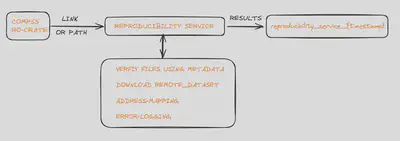Mid-term Blog: Automatic reproducibility of COMPSs experiments through the integration of RO-Crate in Chameleon
Introduction
Hello everyone I’am Archit from India. An undergraduate student at the Indian Institute of Technology, Banaras Hindu University, IIT (BHU), Varanasi. As part of the Automatic reproducibility of COMPSs experiments through the integration of RO-Crate in Chameleon my proposal under mentorship of Raül Sirvent aims to develop a service that facilitates the automated replication of COMPSs experiments within the Chameleon infrastructure.
About the project:
The project proposes to create a service that will have the capability to take a COMPSs crate (an artifact adhering to the RO-Crate specification) and, through analysis of the provided metadata construct a Chameleon-compatible image for replicating the experiment on the testbed.
Progress
It has been more than six weeks since the ReproducibilityService project began, and significant progress has been made. You can test the actual service from my GitHub repository: ReproducibilityService. Let’s break down what the ReproducibilityService is capable of doing now:
Support for Reproducing Basic COMPSs Experiments: The RS program is now fully capable of reproducing basic COMPSs experiments with no third-party dependencies on any device with the COMPSs Runtime installed. Here’s how it works:
Getting the Crate: The RS program can accept the COMPSs workflow from the user either as a path to the crate or as a link from WorkflowHub. In either case, it creates a sub-directory for further execution named
reproducibility_service_{timestamp}and stores the workflow asreproducibility_service_{timestamp}/Workflow.Address Mapping: The ro-crate contains
compss_submission_command_line.txt, which is the command originally used to execute the experiment. This command may include many paths such asruncompss flag1 flag2 ... flagn <main_workflow_file.py> input1 input2 ... inputn output. The RS program maps all the paths for<main_workflow_file.py> input1 input2 ... inputn outputto paths inside the machine where we want to reproduce the experiment. The flags are dropped as they may be device-specific, and the service asks the user for any new flags they want to add to the COMPSs runtime.Verifying Files: Before reproducing an experiment, it’s crucial to check whether the inputs or outputs have been tampered with. The RS program cross-verifies the
contentSizefrom thero-crate-metadata.jsonand generates warnings in case of any abnormalities.Error Logging: In case of any problems during execution, the
std_outandstd_errare stored insidereproducibility_service_{timestamp}/log.Results: If any results do get generated by the experiment, the RS program stores them inside
reproducibility_service_{timestamp}/Results. If we ask for the provenance of the workflow also, the ro-crate thus generated is also stored here only.

- Support for Reproducing Remote Datasets: If a remote dataset is specified inside the metadata file, the RS program fetches the dataset from the specified link using
wget, stores the remote dataset inside the crate, and updates the path in the new command line it generates.
Challenges and End-Term Goals
Support for DATA_PERSISTENCE_FALSE: The RS program still needs to support crates with
dataPersistenceset to false. After weeks of brainstorming ideas on how to implement this, we recently concluded that since the majority ofDATA_PERSISTENCE_FALSEcrates are run on SLURM clusters, and the dataset required to fetch in such a case is somewhere inside the cluster, the RS program will support this case for such clusters. Currently, I am working with the Nord3v2 cluster to further enhance the functionality of ReproducibilityService.Chameleon Cluster Setup: I have made some progress towards creating a new COMPSs 3.3 Appliance on Chameleon to test the service. However, creating the cluster setup script needed for the service to run on a COMPSs 3.3.1 cluster to execute large experiments has been challenging.
Integrating with COMPSs Repository: After completing the support for
dataPersistencefalse cases, we aim to launch this service as a tool inside the COMPSs repository. This will be a significant milestone in my developer journey as it will be the first real-world project I have worked on, and I hope everything goes smoothly.
Stay tuned for the next blog!!